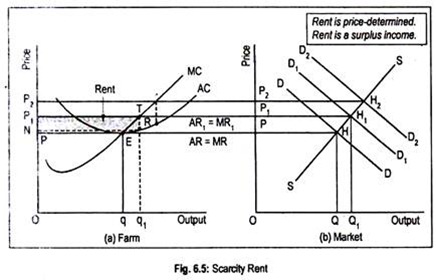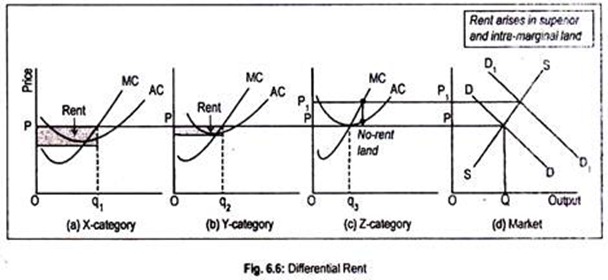Let us study about Ricardo’s Theory of Rent. After reading this article you will learn about: 1. Subject Matter of Ricardo’s Theory of Rent 2. Types of Rent According to Ricardo 3. Limitations.
Subject Matter of Ricardo’s Theory of Rent:
According to Ricardo, economic rent is enjoyed by land only. Rent arises due to the niggardliness of nature. According to Ricardo, rent is producer surplus. Rent is paid for the use of land whose supply is completely inelastic.
Ricardo’s theory is based on the following assumptions:
i. From the standpoint of society, the supply of land is fixed. Thus, the supply of land tends to become completely inelastic—its minimum supply price is zero in the sense that its supplies are available or positive, whether any payment is made or not.
ADVERTISEMENTS:
ii. Law of diminishing marginal product operates.
iii. Malthus’ theory of population is operative. In brief, this theory states that a country’s population has the tendency to become double within 30-35 years.
iv. Land, being a gift of nature, has no cost of production. In view of this, rent does not enter the cost of production or price. Ricardo believed that price influences rent, and not the other way.
Types of Rent According to Ricardo:
Ricardo gave us two types of rent:
ADVERTISEMENTS:
(a) Scarcity rent
(b) Differential rent.
Former type of rent arises due to the limited supply of land and the latter type of rent arises due to the differences in the productivity of land.
(a) Scarcity Rent:
ADVERTISEMENTS:
Let us assume that land available for cultivation is fired and is, therefore, completely inelastic. Labour is the variable input. Let us also assume that marginal product of the variable input, labour, diminishes. As population tends to rise, demand for land rises.
So, according to Ricardo, rent must arise since supply of land is fixed in relation to demand. Land being perfectly inelastic in supply, its price i.e., rent, is essentially demand- determined. Consequently, prices of corn rise and surplus from land emerges. Such surplus is Ricardo’s scarcity rent.
Land is fixed and homogeneous in quality. Land is used for the production of a single crop—corn. To explain Ricardo’s concept of scarcity rent, we use the following diagram. Panel (a) of Pig. 6.5 shows the equilibrium of an agricultural farm, while panel (b) shows the same for the market.
SS is the market supply curve. DD is the initial demand curve for the agricultural product that intersects the SS curve at point H, The market output, thus determined, is OQ and the corresponding price is OP. The corresponding equilibrium at the farm level occurs at point E where MC = MR = AC. A farm thus produces Oq and sells it at the price OP. Since P = AC, there is no surplus and, hence, no rent,
Let us assume that there is an increase in population following Malthusian logic. Thus, a rise in population results in an increase in the demand for corn. Market demand curve now shifts to D1D1and it intersects the SS curve at point H1. A higher price of corn (OP1) thus results, and, to feed more mouths now, a pressure to increase production develops.
Since land is fixed in supply, farms are now forced to increase production by making more intensive use of land. At a higher price OP1, the farm now produces Oq1, where MC and AR1 = MR1 are equal. Since revenues earned by the farm (OP1Tq1) exceed cost (ONRq1), the land, which was initially a free good, now has an economic value. Thus the area NRTP1 represents economic rent or surplus.
Further, increase in the demand for corn following a rise in population will lead to an increase in the price of corn (OP2— determined by the intersection of D2D2 and SS curves at point H2) and, hence, increase in surplus or rent.
The volume of rent is, thus, determined by the price of the product. Thus, rent is a price-determined cost but not price- determining cost. This sort of rent has emerged due to the inelasticity in the supply of land. Since land is fixed in supply, its price is demand-determined.
ADVERTISEMENTS:
(b) Differential Rent:
It is quite likely that all lands are not of uniform quality. Truly speaking, lands are not homogeneous in quality; some lands are more fertile than others.
Such differences in fertility or productivity of land result in the emergence of economic rent. This sort of economic rent has been described by Ricardo as differential rent. Again, some lands for the purpose of building a shopping mall or office are available in excellent location that warrants a high price.
For the sake of simplicity, we assume that, in our society, there are three grades of land where X is the superior and Z is the inferior land and Y grade of land lies between X and Z categories of land. In panel (d), market equilibrium has been shown. Product price is OP.
ADVERTISEMENTS:
The farm accepts this OP price. Ricardo assumed that a cultivator would produce first in the superior quality of land. As its supply is limited, the cultivator would then use the next-best land whenever demand for corn rises consequent upon a rise in population.
Panel (a) of Fig. 6.6 shows that a farmer produces and sells Oq1 output produced in the superior-most land and enjoys a surplus or economic rent (the shaded area). As population rises, demand for corn rises. Since the supply of X-grade land is fixed, people would then use Y-grade land—a less-superior land. Panel (b) shows that at price OP the farmer sells Oq2 output and enjoys a smaller volume of surplus (the shaded area).
Again, because of the population increase, the farmer would now use inferior grade land where production becomes Oq3. However, at the price OP, this output fails to yield any surplus and, hence, economic rent is zero (in panel c) since P = AC. Ricardo called this inferior or grade-Z land as the ‘marginal land’. ‘Marginal land’ does not yield any rent. Rent thus arises only in superior kind (here X- category) and intra-marginal land (here Y- category) — land that lies between superior and marginal land.
ADVERTISEMENTS:
Now, if demand for corn rises price will rise. Consequently, rent will rise. Note that as the demand curve shifts to D1D1, the price of corn rises to OP1. Consequently, surplus or economic rent increases in all grades of land. Now the marginal land or no-rent land yields economic rent and this land becomes intra-marginal land. Thus rent is a price-determined cost, but not a price-determining cost. As price of corn rises, rent rises.
Further, economic rent is an ‘unearned surplus’ since rent is governed by the price of corn.
Limitations of Ricardo’s Theory of Rent:
Ricardo’s theory of rent is subject to criticisms:
i. First, it may be objected that land does not have any original and indestructible powers. Such power of land can be changed in a scientific way.
ii. It is unrealistic to assume that land has only one use. Instead, land has alternative uses. It can be used for variety of purposes. As Ricardo assumed that land has only one use, its supply is completely inelastic. A particular plot of land may be used for the production of either wheat or jute. As land has alternative uses, the supply of land to a particular use cannot be addressed as perfectly inelastic.
iii. Lands are never cultivated in descending order of fertility as was assumed by Ricardo. Actually, cultivation is pursued in accordance with the location of land and other reasons.
ADVERTISEMENTS:
iv. The concept of marginal or no-rent land is not found in reality.
v. According to Ricardo, rent is specific to land. In other words, rent arises only in the case of land. But modern economists have demonstrated that rent arises not only in the case of land but also in the case of other factors of production.
vi. Finally, Ricardo has shown that rent is determined by the price of corn. That is to say, in Ricardo’s theory, rent does enter into cost of production. This Ricardian idea becomes true if we consider the supply of land from the viewpoint of the economy as a whole. If supply of land is considered from the viewpoint of a firm or industry, rent then determines price and, hence, rent will enter cost of production.

